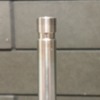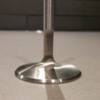quote:
Originally posted by LTP:
I finally got around to weighing valves at the local grocery store.
11800EPN 2.19" intake valve 126g. SI Silverline 1816 1.71" exhaust valve 104g. FoMoCo intake 141g. FoMoCo exhaust 124g. Interestingly the new valves slide "sort of" snuggly inside the EPN valve guides I purchased. The FoMoCo valves will not fit. I tried measuring the stems with a digital caliper but it was all over the place. A proper micrometer would be in order. Regardless, the valve stems on the new valves are slightly smaller and would not work in the stock head unless valve guide liners were installed and honed.
The weights of my new SS valves are similar to the Racemaster series but I'm not sure if this means anything other than, same sized valves made from similar stainless will weigh close to the same...Or the valves are all made in the same place.
I'll have to wait and see if this was a horrific blunder, I doubt it, or a non event.
You need to install the guides first, THEN run a reamer through them to get the correct clearances.
The stem of the valve is made to fit with the correct clearances inside the reamed guide.
Very often when you press the guide in, it will be a little out of round from the process. After all, the hole in the head should be .500". The guide .501-.502, which is an interference fit.
That squashes the quide just a hair in order to hold it in place. That's why you need the reamer also.
Incidentally, PRESS them in. Don't HAMMER them in. That will peen over the tip of the guide.
IF after you install the guide AND after you ream it, the valve stem won't go perfectly through or hangs up just a bit, then the valve stem is bent. Throw that one away. It can't be used or repaired. It needs to be perfect out of the box.
Also, you should not be able to wobble the valve from side to side in the guide. It has to ride perfectly within the guide.
Use a drop of oil on each stem during assembly. It won't hurt anything, but just a drop.
You are also going to regrind the seats in the heads after you install the guides. The stone pilot has to ride perfectly in the guide as well.
The pilots for the stones are made in 11/32, 11/32 + .001", and +.002".
Only grind the seats the minimum that you can and use lapping compound so that you can see how the valve sits in the seat, and measure them with a dial caliper until you get the width that you need.
As far as the weight of the valves themselves, the EPN's are ok with their weights. What the race teams do these days is use a reduced diameter valve stem of either 7 or 6mm.
Those are best left to pure race engines since they will bend much more easily then an 11/32" will AND if you float the valves even momentarily you will probably reduce the entire engine to a pile of expensive rubble.
Even titanium valves should just be used in a race engine that gets torn down virtually after every race.
The titanium is softer then a steel valve and the stems will have an accelerated wear.
There IS a coating for the stems that HELP in adding not even miles to their life, it's measured in HOURS like an aircraft engine is, but that coating is factory installed so best just put them on the shelf for everyone to play with and handle and ooo and awe at?

If all things are given equal, i.e., same size, same materials, the weights are going to be virtually the same. One thing that can affect the weight is the length of the stem. There are at least two lengths that I am aware of and those are standard lengths and +.100". The plus is so that there is more room above the valve locks and spring retainers for the rocker arm tip clearance.
Years ago Chrysler and Ford reduced the weight of the valves in the Hemi and the 427 by making the stems hollow and filling them with sodium.
I don't know about the Hemis but in the case of the Fords the engines AFTER headers would be installed would develop brittleness in the stems PROBABLY because of the cool air getting to the valves because of the freer flowing exhausts? As a result the stem would snap and the engine would drop a valve into the cylinder resulting in a cracked combustion chamber, a bent connecting rod, and usually a cracked block cylinder wall.
That idea was just a little bit of an engineering oversight?




